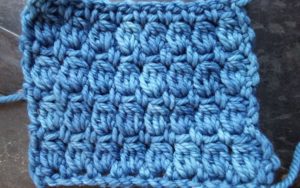 There are times when you can come across a crochet stitch that breaks all the rules, for me the stitch I refer to as Titter Tat does just that. This stitch creates an open stretchy pattern whose stitches appear to be sideways, and you do not chain at the beginning of a row, you simply begin working your stitches.
There are times when you can come across a crochet stitch that breaks all the rules, for me the stitch I refer to as Titter Tat does just that. This stitch creates an open stretchy pattern whose stitches appear to be sideways, and you do not chain at the beginning of a row, you simply begin working your stitches.
I have used this stitch in the Wine Country Throw that is found in the October 2016 issue of Crochet World, it does have a bit of stretch, which can be deceiving when attempting to get a desired size, but I really love the affect.
Begin with a chain that is a multiple of 4, then add 2 more chains. Single crochet in the second chain from the hook, [chain 4, skip 3 chains, single crochet in next chain] repeat everything in the brackets across, then turn. Do not chain anything, and simply work (2 double crochet, chain 3, single crochet) in all chain 4 loops across, and then turn your work. This can be a little awkward with the first stitch as it seems a bit distorted as it is pulled over, this is the correct approach as it will set the first stitches up the match the rest. All subsequent rows are worked the same, no beginning chain, working (2 double crochet, chain 3, single crochet) in all chain 3 spaces across. You work this until you have the desired length. This stitch can really benefit from blocking, but the type of yarn can influence how well this works.
The more formal written pattern looks like this:
Ch a multiple of 4 +2
Row 1: Sc in 2nd ch from hook, [ch 4, sk 3, sc in next ch] across, turn.
Row 2: [(2dc, ch 3, sc) in ch-4 sp] across, turn.
Row 3-desired length: [(2dc, ch 3, sc in each ch-3 sp] across, turn.
You may want to add a solid border to the stitch to limit the stretch, but that is a personal choice. If you are seeking to practice this stitch and create a throw for charity you may want to consider your local foster youth programs. Often foster kids in any community have limited personal belongings, and upon during 18 are now legal adults with in many cases nothing to begin their own households. Foster youth programs try an ease this transition.



